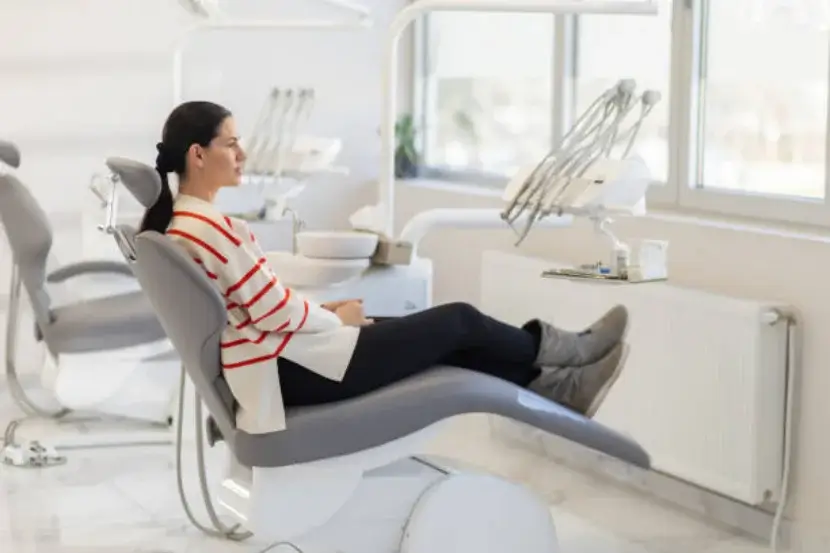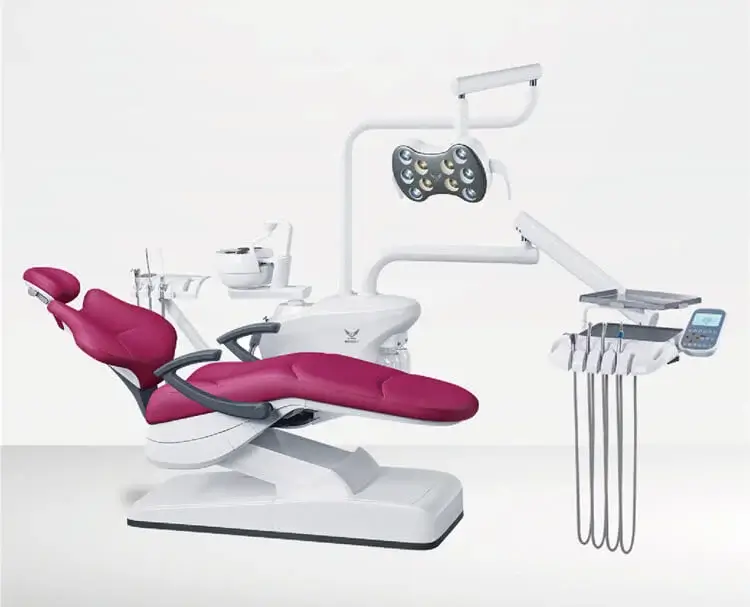
Hydraulic dental chairs are designed with a focus on functionality and patient comfort. They feature adjustable headrests, armrests, and footrests, ensuring that patients can be positioned comfortably during procedures. These chairs utilize a hydraulic system that allows for smooth adjustments in height and angle, catering to the diverse needs of dental practices. Imagine a patient walks into your clinic and sits in one of these chairs. They’ll experience features like adjustable headrests, armrests, and footrests, all designed to ensure maximum comfort.
Foshan Gladent Medical Equipment Co., Ltd.’s GD-S600 hydraulic dental unit exemplifies these attributes with its advanced hydraulic cylinder system, offering stability and smooth operation. Additionally, the GD-S450 floor-fixed dental unit is equipped with ergonomic designs like an integrated cast aluminum backrest for enhanced patient security.
The hydraulic system is the core mechanism enabling the efficient operation of these chairs. It consists of components such as a hydraulic pump, cylinders, pistons, valves, and hoses. These components convert hydraulic pressure into mechanical motion, allowing the chair to move. This technology ensures precision in positioning while maintaining durability under frequent use.
For instance, the GD-S350 implant type dental unit incorporates an imported hydraulic system that ensures smooth movements and long-lasting performance.
Hydraulic dental chairs offer several advantages:
Hydraulic chairs can support a wide range of patient weights, accommodating diverse patient needs. The GD-KID children’s dental unit from Foshan Gladent Medical Equipment Co., Ltd., for example, is specially tailored to meet pediatric requirements while maintaining safety and comfort.
The operation begins when the control panel activates the hydraulic pump. This pump pressurizes the fluid within the system. As the fluid enters the cylinders, it pushes the pistons, causing the chair to move. Valves regulate this flow to ensure precise adjustments.
The imported hydraulic cylinder used in Gladent’s GD-S600 model exemplifies this functionality by providing consistent power and smooth transitions during lifting or reclining motions.
Adjustability is crucial for both patient comfort and practitioner convenience. Hydraulic systems allow dentists to position patients at optimal angles without exerting excessive effort. Ergonomic designs further enhance usability by minimizing physical strain on practitioners during long procedures.
For instance, the GD-S450 model features an ergonomic compensation system that provides excellent support while ensuring stability during operations.
Comfort is a priority in modern dental care. Hydraulic chairs are equipped with cushioned surfaces made from materials like microfiber leather for softness and breathability. Adjustable features such as headrests and armrests adapt to individual patient needs.
The GD-S350 model includes a baby skin-like microfiber leather cushion that is both soft and corrosion-resistant. Such innovations contribute significantly to reducing anxiety among patients during treatments.
Hydraulic and electric dental chairs differ significantly in their mechanisms and functionalities. Hydraulic dental chairs operate through a hydraulic system, utilizing components such as pumps, cylinders, pistons, and valves. The hydraulic pressure generated enables smooth and precise movements of the chair. On the other hand, electric dental chairs rely on electric motors for movement, offering programmable settings for specific positions.
Hydraulic systems are known for their reliability and ability to handle heavier weights without compromising stability. For instance, the GD-S600 hydraulic dental unit from Foshan Gladent Medical Equipment Co., Ltd. exemplifies this with its imported hydraulic cylinder that ensures smooth operation even under high loads. In contrast, electric chairs like those equipped with advanced electronic controls provide a broader range of automated adjustments but may require more complex maintenance.

Hydraulic dental chairs offer several advantages that make them a popular choice among dental practitioners.
Advantages:
Disadvantages:
The GD-KID children’s dental unit is an excellent example of how hydraulic technology can be tailored for pediatric use while maintaining safety and comfort.
Electric dental chairs provide unique benefits but also have certain limitations.
Advantages:
Limitations:
While electric chairs offer innovative features, hydraulic models like the GD-S350 implant type dental unit remain a reliable choice due to their simplicity and durability.
Ergonomics plays a crucial role in selecting the right dental chair. A well-designed chair minimizes physical strain on dentists while ensuring patient comfort during procedures. Adjustable headrests, armrests, and footrests are essential features that enhance usability. For example, the GD-S600 model incorporates an ergonomic compensation system that provides excellent support while maintaining stability.
Dental practitioners should prioritize chairs with cushioned surfaces like microfiber leather cushions found in Foshan Gladent’s products. These materials are not only comfortable but also easy to clean and maintain hygiene standards.
When investing in dental equipment, it is essential to consider quality standards and certifications. Products from Foshan Gladent Medical Equipment Co., Ltd. meet stringent requirements such as CE certification, EU ISO13485 certification, and US FDA medical device management system certification. These certifications ensure that the equipment adheres to international safety and performance standards.
Models like the GD-S450 floor-fixed dental unit demonstrate high-quality craftsmanship with features such as cast aluminum backrests for enhanced durability.
Durability is a key factor when purchasing hydraulic dental chairs. High-quality materials like aluminum alloys contribute to the longevity of these units. Additionally, self-lubricating components reduce wear over time, as seen in the imported hydraulic systems used in Gladent’s products.
Maintenance requirements should also be considered. Regular inspection of hydraulic fluid levels and components such as valves ensures optimal performance. The GD-S350 model stands out with its corrosion-resistant baby skin-like microfiber leather cushion, which adds to its durability while maintaining patient comfort.
Hydraulic chairs use fluid pressure for movement, offering smooth adjustments suitable for heavier weights. Electric chairs rely on motors for movement and often include programmable settings but may require more complex maintenance.
Hydraulic systems allow precise positioning with minimal effort. Ergonomic designs further enhance comfort by reducing strain during long procedures.
Yes, they are constructed using robust materials like aluminum alloys and feature self-lubricating components that extend their lifespan under frequent use.
Regular maintenance includes checking fluid levels, inspecting hoses for leaks, and ensuring valves function properly to maintain performance.
Yes, specialized models like Foshan Gladent’s GD-KID are designed specifically for pediatric use with added safety features such as secure belts and child-friendly aesthetics.
For more information about our products or customization services offered by Foshan Gladent Medical Equipment Co., Ltd., visit our website or contact us directly!